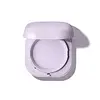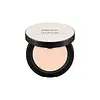What's inside
What's inside
 Key Ingredients
Key Ingredients

 Benefits
Benefits

 Concerns
Concerns

 Ingredients Side-by-side
Ingredients Side-by-side

Silica
AbrasiveDimethicone/Vinyl Dimethicone Crosspolymer
Skin ConditioningCaprylic/Capric Triglyceride
MaskingMica
Cosmetic ColorantMethicone
EmollientCI 77891
Cosmetic ColorantCI 77742
Cosmetic ColorantEthylhexylglycerin
Skin ConditioningNephrite Powder
AbrasiveDimethicone
EmollientGlyceryl Caprylate
EmollientButylene Glycol
HumectantWater
Skin ConditioningLactic Acid/Glycolic Acid Copolymer
Skin ConditioningKaolin
AbrasiveGlycerin
HumectantHydrolyzed Hyaluronic Acid
HumectantTin Oxide
AbrasiveMalpighia Glabra Fruit Extract
Skin ConditioningPropanediol
SolventHydrolyzed Corn Starch
HumectantPinus Densiflora Leaf Extract
AntimicrobialPolyquaternium-10
Saururus Chinensis Extract
Skin ConditioningEuterpe Oleracea Fruit Extract
1,2-Hexanediol
Skin ConditioningMother Of Pearl
AbrasiveHedychium Coronarium Root Extract
MaskingTocopherol
AntioxidantSodium Magnesium Silicate
Disodium EDTA
Sodium Benzoate
MaskingLactic Acid
BufferingPotassium Sorbate
PreservativeGlutathione
Diamond Powder
AbrasiveXanthan Gum
EmulsifyingSilica, Dimethicone/Vinyl Dimethicone Crosspolymer, Caprylic/Capric Triglyceride, Mica, Methicone, CI 77891, CI 77742, Ethylhexylglycerin, Nephrite Powder, Dimethicone, Glyceryl Caprylate, Butylene Glycol, Water, Lactic Acid/Glycolic Acid Copolymer, Kaolin, Glycerin, Hydrolyzed Hyaluronic Acid, Tin Oxide, Malpighia Glabra Fruit Extract, Propanediol, Hydrolyzed Corn Starch, Pinus Densiflora Leaf Extract, Polyquaternium-10, Saururus Chinensis Extract, Euterpe Oleracea Fruit Extract, 1,2-Hexanediol, Mother Of Pearl, Hedychium Coronarium Root Extract, Tocopherol, Sodium Magnesium Silicate, Disodium EDTA, Sodium Benzoate, Lactic Acid, Potassium Sorbate, Glutathione, Diamond Powder, Xanthan Gum
Talc
AbrasiveMica
Cosmetic ColorantCaprylic/Capric Triglyceride
MaskingPolymethyl Methacrylate
Silica
AbrasiveHdi/PPG/Polycaprolactone Crosspolymer
Phenyl Trimethicone
Skin ConditioningDimethicone
EmollientTriethoxycaprylylsilane
Octyldodecyl Stearoyl Stearate
Emollient1,2-Hexanediol
Skin ConditioningGlyceryl Caprylate
EmollientCI 77491
Cosmetic ColorantMethicone
EmollientHydrogenated Lecithin
EmulsifyingCI 77492
Cosmetic ColorantParfum
MaskingCalamine
AbsorbentHouttuynia Cordata Powder
Skin ConditioningCI 77499
Cosmetic ColorantWater
Skin ConditioningButylene Glycol
HumectantMentha Arvensis Leaf Extract
MaskingTalc, Mica, Caprylic/Capric Triglyceride, Polymethyl Methacrylate, Silica, Hdi/PPG/Polycaprolactone Crosspolymer, Phenyl Trimethicone, Dimethicone, Triethoxycaprylylsilane, Octyldodecyl Stearoyl Stearate, 1,2-Hexanediol, Glyceryl Caprylate, CI 77491, Methicone, Hydrogenated Lecithin, CI 77492, Parfum, Calamine, Houttuynia Cordata Powder, CI 77499, Water, Butylene Glycol, Mentha Arvensis Leaf Extract
 Reviews
Reviews

Ingredients Explained
These ingredients are found in both products.
Ingredients higher up in an ingredient list are typically present in a larger amount.
1,2-Hexanediol is a synthetic liquid and another multi-functional powerhouse.
It is a:
- Humectant, drawing moisture into the skin
- Emollient, helping to soften skin
- Solvent, dispersing and stabilizing formulas
- Preservative booster, enhancing the antimicrobial activity of other preservatives
Butylene Glycol (or BG) is used within cosmetic products for a few different reasons:
Overall, Butylene Glycol is a safe and well-rounded ingredient that works well with other ingredients.
Though this ingredient works well with most skin types, some people with sensitive skin may experience a reaction such as allergic rashes, closed comedones, or itchiness.
Learn more about Butylene GlycolThis ingredient is an emollient, solvent, and texture enhancer. It is considered a skin-softener by helping the skin prevent moisture loss.
It helps thicken a product's formula and makes it easier to spread by dissolving clumping compounds.
Caprylic Triglyceride is made by combining glycerin with coconut oil, forming a clear liquid.
While there is an assumption Caprylic Triglyceride can clog pores due to it being derived from coconut oil, there is no research supporting this.
Learn more about Caprylic/Capric TriglycerideDimethicone is a type of synthetic silicone created from natural materials such as quartz.
What it does:
Dimethicone comes in different viscosities:
Depending on the viscosity, dimethicone has different properties.
Ingredients lists don't always show which type is used, so we recommend reaching out to the brand if you have questions about the viscosity.
This ingredient is unlikely to cause irritation because it does not get absorbed into skin. However, people with silicone allergies should be careful about using this ingredient.
Note: Dimethicone may contribute to pilling. This is because it is not oil or water soluble, so pilling may occur when layered with products. When mixed with heavy oils in a formula, the outcome is also quite greasy.
Learn more about DimethiconeGlyceryl Caprylate comes from glycerin and caprylic acid, a fatty acid from coconut. It has emollient and emulsifier properties.
As an emollient, it helps hydrate your skin. Emollients work by creating a barrier on your skin to trap moisture in, helping to keep your skin soft and smooth.
On the other hand, emulsifiers prevent ingredients (such as oil and water) from separating.
Learn more about Glyceryl CaprylateMethicone is a type of silicone and is a simpler form of dimethicone.
Silicones are used to enhance the texture of products and have emollient properties. Methicone is used to give products a silky texture and improves spreadability.
Mica is a naturally occurring mineral used to add shimmer and color in cosmetics. It can also help improve the texture of a product or give it an opaque, white/silver color.
Serecite is the name for very fine but ragged grains of mica.
This ingredient is often coated with metal oxides like titanium dioxide. Trace amounts of heavy metals may be found in mica, but these metals are not harmful in our personal products.
Mica has been used since prehistoric times throughout the world. Ancient Egyptian, Indian, Greek, Roman, Aztec, and Chinese civilizations have used mica.
Learn more about MicaSilica, also known as silicon dioxide, is a naturally occurring mineral. It is used as a fine, spherical, and porous powder in cosmetics.
Though it has exfoliant properties, the function of silica varies depending on the product.
The unique structure of silica enhances the spreadability and adds smoothness, making it a great texture enhancer.
It is also used as an active carrier, emulsifier, and mattifier due to its ability to absorb excess oil.
In some products, tiny microneedles called spicules are made from silica or hydrolyzed sponge. When you rub them in, they lightly polish away dead skin layers and enhance the penetration of active ingredients.
Learn more about SilicaWater. It's the most common cosmetic ingredient of all. You'll usually see it at the top of ingredient lists, meaning that it makes up the largest part of the product.
So why is it so popular? Water most often acts as a solvent - this means that it helps dissolve other ingredients into the formulation.
You'll also recognize water as that liquid we all need to stay alive. If you see this, drink a glass of water. Stay hydrated!
Learn more about Water